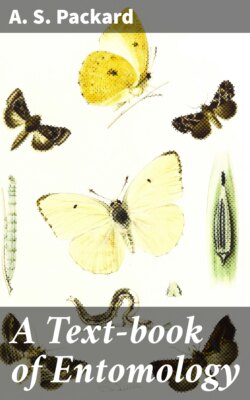Читать книгу A Text-book of Entomology - A. S. Packard - Страница 38
На сайте Литреса книга снята с продажи.
ОглавлениеFig. 98.—Meso- (G2) and metathoracic ganglia (G1), with the apodemes of Gryllotalpa.—After Graber.
Fig. 99.—Parts of the mesothorax of Dyticus: A, mesosternum; 3.a, præscutum; 3.b, scutum; 3.c, scutellum; 3.d, postscutellum; 3.e, parapteron; 3.g, mesosternum; 3.f, episternum; 3.h, epimerum; 3.s, medifurca or entothorax.
Fig. 100.—Parts of the metathorax of Dyticus: A, metasternum; 4.a, præscutum; 4.b, scutum; 4.c, scutellum; 4.d, postscutellum; 4.e, parapteron; 4.f, episternum; 4.g, metasternum; 4.h, epimerum; 4.s, postfurca.—This and Figs. 97 and 99 from Audouin, after Newport.
The apodemes.—The thorax is supported within by beam-like processes, or apodemes, which pass inward and also form attachments for the muscles. Those passing up from the sternum form the entothorax of Audouin, and the process of each thoracic segment is called respectively the antefurca, medifurca, and postfurca. In the Orthoptera (Caloptenus and Anabrus), the antefurca is large, thin, flattened, directed forward, and bounds each side of the prothoracic ganglion. In the Coleoptera two plates (Fig. 97, 2.s) arise from the inside of the sternum and “form a collar or leave a circular hole between them for the passage of the nervous cord” (Newport). The medifurca is a pair of flat processes which diverge and bridge the commissure, while the postfurca is situated under the commissure. In beetles (Dyticus) Newport states that it is expanded into two broad plates, to which the muscles of the posterior legs are attached. Graber also notices in the mole cricket between the apodemes of the meso- and metathorax, a flattened spine (Fig. 98, do) with two perforations through which pass the commissures connecting the ganglia. Besides these processes there are large, thin, longitudinal partitions passing down from the tergum (or dorsum), called phragmas; they are most developed in those insects which fly best, i.e. in Coleoptera (Figs. 97–101), Lepidoptera, Diptera, and Hymenoptera, none being developed in the prothorax. (The term phragma has also been applied to a partition formed by the inflexed hinder edge of this segment, and is present only in those insects in which the prothorax is movable.—Century Dictionary.) All these ingrowths may be in general termed apodemes. There are similar structures in Crustacea and also in Limulus; but Sharp restricts this term to minute projections in beetles (Goliathus) situated at the sides of the thorax near the wings. (Insecta, p. 103, Fig. 57.) The internal processes arising from the sternal region have been called endosternites.
Fig. 101.—Internal skeleton of Lucanus cervus, ♂, head: A, antenna; f, mandible; d, mentum; 2, 4, tendons of mandible; f, u, t, parts of the tentorium; 3 e, labial muscles. Thorax: 2, prothorax; 3, 4, meso- and metathorax fused solidly together; 3 r, acetabulum of prothorax, into which the coxa is inserted; 2 s, sternum; 3t, acetabulum of mesothorax, 4r, of metathorax; 3 s, mesothoracic sternum fused with that of the metathorax (4g); 4 s, apodeme.—After Newport.
The acetabula.—These are the cavities in which the legs are inserted. They are situated on each side of the posterior part of the sternum, in each of the thoracic segments. They are, in general, formed by an approximation of the sternum and epimerum, and sometimes, also, of the episternum, as in Dyticus (Fig. 97, A). This consolidation of parts, says Newport, gives an amazing increase of strength to the segments, and is one of the circumstances which enables the insect to exert an astonishing degree of muscular power.
| Tabular View of the Segments, Pieces, and Appendages of the Thorax | ||
| Name of Segment | Pieces (Sclerites) | Appendages |
|---|---|---|
| 1. Prothorax | Pronotum, sometimes differentiated into | |
| Scutum | 1st pair of legs | |
| Scutellum | Patagia | |
| Episternum | ||
| Epimerum | ||
| Sternum | ||
| Antefurca | ||
| 2. Mesothorax | Præscutum | |
| Scutum | 2d pair of legs | |
| Scutellum | 1st pair of wings | |
| Proscutellum | Tegulæ | |
| Episternum | Squamæ (Alulæ) | |
| Epimerum | Peritreme | |
| Sternum | ||
| Mesofurca | ||
| Mesophragma | ||
| Apodemes | ||
| 3. Metathorax | Præscutum | |
| Scutum | 3d pair of legs | |
| Scutellum | 2d pair of wings | |
| Postscutellum | (Halteres of Diptera) | |
| Episternum | ||
| Epimerum | ||
| Sternum | ||
| Postfurca | ||
| Metaphragma | ||
| Apodemes |
Fig. 102.—External anatomy of the trunk of Hydröus piceus: A, sternal—B, tergal aspect; 2, pronotum; 2 a, prosternum; 2 f, episternum; 3 a, præscutum; 3 b, scutum; 3 c, scutellum; 3 d, postscutellum; 3 g, mesosternum; 3 h, episternum; 3 f, epimerum; 3 i, crest of the mesosternum; 3 a, parapteron; 3 k, coxa; 4 a, metapræscutum; 4 b, metascutum; 4 c, metascutellum; 4 d, postscutellum; 4 e, tegula; 4 f, episternum; 4 h, epimerum; 4 g, metasternum; 4 i, crest of metasternum; 4 k and l, coxa; 4 m, trochanter; n, femur; o, tibia; p, tarsus; q, unguis; 7–11, abdominal segments.—After Newport.
